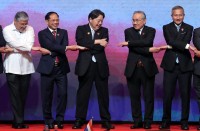(Eagle News) — A stronger currency swap among member countries of the Association of Southeast Asian Nations (ASEAN) took effect on Tuesday, June 23, which would enably the Philippines to borrow up to $22.76 billion from the facility as a signatory to this, the Department of Finance said.
The amended Chiang Mai Initiative Multilateralization (CMIM) agreement took effect Tuesday “offering a stronger currency swap arrangement and financial safety net” among ASEAN member-states and their partner-economies in the region.
Finance Secretary Carlos Dominguez III signed the amended CMIM in December last year, while the Minister of Finance, Planning, and Industry of Myanmar signed the amended agreement on June 16, completing all 27 signatures needed for the amended CMIM agreement to enter in force.
According to the DOF’s International Finance Group (IFG) of the Department of Finance (DOF), all finance ministers and central bank governors of the ASEAN and its “Plus 3” partners Korea, Japan and China, along with the Hong Kong Monetary Authority, have signed the amended CMIM.
-Averting a crisis-
As a signatory, the Philippines may be able to borrow up to US$22.76 billion from the facility to help avert an impending or actual balance of payments (BOP) crisis. The BOP is also known as balance of international payments
In turn, the Philippines will also be able to provide liquidity assistance to another CMIM member if so needed.
Under the CMIM, each member-state can swap its local currency with US dollars based on certain conditions when faced with short-term liquidity or BOP problems.
The DOF said that this CMIM first came into effect in March 2010. It aims to address balance-of-payments (BOP) and short-term liquidity difficulties in the ASEAN and its partners Korea, Japan and China along with Hong Kong.
“The current size of the CMIM has since doubled to US$240 billion and its International Monetary Fund (IMF)-delinked portion has since been raised to 30 percent, which means member-economies could draw up to 30 percent of their maximum borrowing amount, without being subjected to lending conditions set by the IMF,” the DOF said.
-Flexibility on supporting period for financing linked to IMF lending-
A key point in the amended CMIM is the flexibility on the supporting period for financing linked to IMF-lending conditions.
“This will be done by allowing multiple renewals to match the supporting period of the IMF-supported programs. Adjustments of the other financing terms under the CMIM, such as the disbursement date, have also been made to secure consistency with the IMF-supported program, in the case of co-financing arrangements,” the DOF explained.
The amended agreement also strengthened the CMIM’s coordination with the IMF by establishing a set of operational guidelines.
These guidelines target the “creation of a shared view on economic and financial situations, financing needs and policy recommendation for co-financing.” The modalities of early information-sharing with IMF have been aligned with this strengthened coordination process, the DOF said.
It allowes for two facilities:
– a Precautionary Line which is basically a crisis prevention facility which can be tapped for potential crisis or liquidity difficulties; and
– the Stability Facility which is for crisis resolution.
DOF also lists the other important features of the amended CMIM: a reinforced program review and monitoring process; an upgraded series of financing conditions to match the relevant IMF-supported program; and easing of rules on
· The program review and monitoring process are reinforced by clarifying the issues to be reviewed and monitored after a CMIM Arrangement is approved.
· A series of financing conditions has been upgraded to match the relevant IMF-supported program.
· Rules on confidentiality have been eased so that some CMIM-related information could be provided: 1) for media coverage to bolster market confidence when the CMIM is activated, and 2) to third parties
(Eagle News Service)








